On the 29th of September 1825 the English artist George Chinnery landed at Macao. He had sailed aboard the ship Hythe from Calcutta two-and-a-half months before, after twenty-three years in which he had established himself as the leading European artist in India. In Calcutta it was rumored that Chinnery had left India on a short trip for the good of his health; he himself claimed that he was trying to get away from his wife. But the truth was that he was desperately in debt, and hoped that on the China coast he would gain refuge from his creditors.
As it turned out, the artist never returned to India, nor to Europe. From 1825 until his death in 1852 he remained on the South China coast. For most of this time he lived in Macao. Until the mid 1830s he made periodic visits to Guangzhou; he also visited Whampoa, Lintin (in 1837) and Hong Kong (in 1846), but Macao became his home until his death, and he lies buried in the calm oasis of Macao's Protestant cemetery.
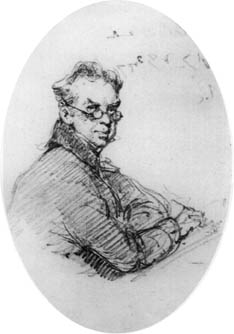 Self Portrait.
GEORGE CHINNERY (ō1774†1852). Crayon, ca 1830.
Private Collection.
Photograph: Courtesy of the Larger Galleries.
Self Portrait.
GEORGE CHINNERY (ō1774†1852). Crayon, ca 1830.
Private Collection.
Photograph: Courtesy of the Larger Galleries.
During these years and despite bouts of illness, Chinnery sketched assiduously. "He gets up at 5 o'clock and goes out and makes sketches and earns his breakfast certainly [...]"1 observed a visitor in 1833. His drawings of Macao's subjects can be numbered in thousands. Many of these are held in the Victoria & Albert Museum, in London; the Toyo Bunko (Oriental Library) in Tokyo; and the Peabody Essex Museum, in Salem, Massachusetts; while other significant groups are in the care of the Museu de Arte de Macau (Macao Art Museum)― former Luís de Camões Museum -- in Macao; the Hong Kong Museum of Arts, in Hong Kong; the Library of the Geography Society of Lisbon, in Lisbon; The British Museum, in London; and the Birmingham City Museum and Art Gallery, in Birmingham. Some of these drawings have traveled almost as widely as Chinnery himself; the Toyo Bunko group, for example, found their way into Beijing library of the Australian journalist G. E. Morrison, from whom they were acquired by Baron Iwaski Hisaya and brought to Japan.
Chinnery earned his living principally as a painter of portraits. In India he had received numerous lucrative commissions, especially large portraits of judges, military commanders and Governors-General; he did not, however, paint the great architectural monuments of India. Perhaps this was because dine series of such views had been painted and published by his predecessors in India, William Hodges and Thomas and William Daniell. Perhaps he sensed that these subjects were not ideally suited to his particular talents. Instead Chinnery carried out a series of intimate studies (both drawings and small oils) of Bengal villages.
When he left India in 1825, he forfeited much of the professional standing which he had built up in the course of his years in the subcontinent. No longer was he the dashing impresario who presided over the capital of British India, sought after by the wealthy and the successful. Now in Macao he was a refuge from his creditors, a precarious figure in a much smaller community; and no doubt he was obliged to take whatever work he was offered. In Macao he painted several topographical oils of a kind which he had not painted in India. In these paintings the architecture is less closely detailed than in the Daniells' work; in his oils, Chinnery often seems to be less interested in architecture for its own sake than as a vehicle for dramatic effects of light and shade, or as a theatrical backdrop to the lively human drama in the foreground.
But when Chinnery took up his pencil to sketch, he looked at his subjects (whether architectural or human) very closely indeed. In Macao Chinnery had the opportunity - and the leisure - to develop his extraordinary talents in drawing and watercolour, the media in which, it may be claimed, his true genius lay. He seems never to have tired of sketching the people, the buildings and the streets of the small international settlement of Macao, often repeating a figure or a detail several times until he felt satisfied with it.
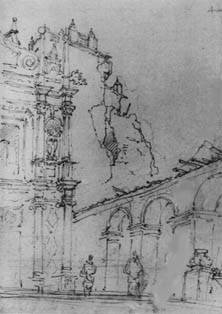 Illustration 1
The extreme right of St. Paul's Church (São Paulo) façade and the adjoining arcade, after the big fire of 1835.
GEORGE CHINNERY (°1774-†1852).
Crayon. Dated "3 August 1835".
Collection of the Macau Art Museum, Macao.
Photograph: Courtesy of the Martyn Gregory Gallery.
Illustration 1
The extreme right of St. Paul's Church (São Paulo) façade and the adjoining arcade, after the big fire of 1835.
GEORGE CHINNERY (°1774-†1852).
Crayon. Dated "3 August 1835".
Collection of the Macau Art Museum, Macao.
Photograph: Courtesy of the Martyn Gregory Gallery.
Regarded as documents, Chinnery's drawings have a particular value in that so many of them are precisely dated (often to the day), and moreover annotated in the 'Gurney' system of shorthand which he must have learnt in England in his youth - his grandfather and (probably) his father were writing-masters in London. These shorthand notes were intended for Chinnery's use when, at some later date, he undertook a painting in water colours or in oils. Typical notes might read (in translation) "[...] fully to be relied on [...]", or "[...] the upper part out of proportion [...]" or again "[...] remember the very beautiful effect of the light coating all the end of the church leaving the pillar [...] and all the rest in shade."
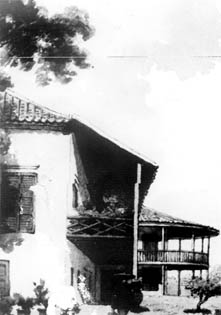 House with verandah in Praya Grande (Praya Grande) [probably the residence of Lord Napier] - detail.
GEORGE CHINNERY (°1774-†1852).
Pen, ink, and water colour.
Private Collection.
Photograph: Courtesy of Christie's.
House with verandah in Praya Grande (Praya Grande) [probably the residence of Lord Napier] - detail.
GEORGE CHINNERY (°1774-†1852).
Pen, ink, and water colour.
Private Collection.
Photograph: Courtesy of Christie's.
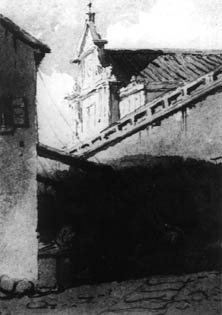 Alleway and partial view of St. Dominick's (São Domingos) Church façade - detail.
GEORGE CHINNERY (°1774-†1852).
Crayon. ca. 1830.
Private Collection.
Alleway and partial view of St. Dominick's (São Domingos) Church façade - detail.
GEORGE CHINNERY (°1774-†1852).
Crayon. ca. 1830.
Private Collection.
Chinnery's drawings have an added significance that may -- perhaps most -- of the sixteenth and seventeenth century buildings which were drawn by him in Macao were demolished or radically altered during his time in Macao, or within a few decades of his death. The most spectacular example is the great collegiate of the Igreja de São Paulo (St. Paul's church), completed in 1638, with its tiered façade incorporating a rich diversity of symbols derived from Italian and Portuguese, Chinese and Japanese cultural traditions. A drawing by Chinnery, dated "18 October 1834", shows the church from the foot of the flight of granite steps, with the (slightly shaded) building of the Jesuit college beside it. At the time of this drawing, however, the collegiate buildings were occupied by a battalion of troops; and in the following January, a fire destroyed much of the body of the church, library and college, with their chunambo walls and wooden roofs. A sketch drawn shortly after the fire, carrying the date "3 August 1835",(Illustration 1) shows the right-hand side of the (intact) façade and the adjoining arcade, with a few lines straggling downward to indicate the extent of the devastation alongside.
In certain cases Chinnery focused his attention unambiguously on a specific structure. Examples are the eighteenth-century gateway to the Seminário de São José (St. Joseph's Seminary), a late Baroque, Borrominesque design which is both striking and untypical of Macao; and the house near the southern end of the Praia Grande (Praya Grande) which was occupied by (among others)the American merchant Robert Bennet Forbes, 2and, reputedly, the ill-fated British envoy Lord Napier. The latter building is depicted by Chinnery from the side, showing the construction of the verandah and its semicircular projection.
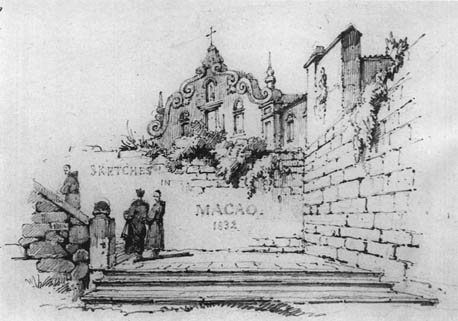 Illustration 2
Composition with the upper section of St. Augustine's (Santo Agostinho) Church façade.
(°1774-†1852).
Crayon. Dated "1832".
Inscribed "Sketches in Macao 1832".
Private Collection. Photograph: Courtesy of the Martyn Gregory Gallery.
Illustration 2
Composition with the upper section of St. Augustine's (Santo Agostinho) Church façade.
(°1774-†1852).
Crayon. Dated "1832".
Inscribed "Sketches in Macao 1832".
Private Collection. Photograph: Courtesy of the Martyn Gregory Gallery.
More often, however, Chinnery's drawings of notable façades are obliquely angled views, in which the nominal subjects are partly obscured by walls or intervening buildings. It was evidently his habit to group some of his finished works into sets, for certain drawings are composed as frontispieces, carrying such inscriptions as "Sketches in Macao 1832".(Illustration. 2) In this case we are shown part of the distinctive façade of the Igreja de Santo Agostinho (St. Augustine's Church): its ogival decorations, almost Rococo in their exuberance, were replaced some twenty years after Chinnery's death by the plainer pediment which survives today.
The church which lay closest to Chinnery's own lodgings (at 8, Rua Inácio Baptista) was São Lourenço (St. Lawrence's), which in the early years of the nineteenth century had been grandly rebuilt in stone. Its two towers, capped with tiled pyramidions, appear obliquely in a number of Chinnery's drawings, although we are often shown more of the wall and the steps beneath them than the church itself. The twin towers looked down upon one of the most substantial houses in Macao, which was at various times rented by some of the leading Western merchants; it was sometimes known as the 'casa das dezasseis colunas' ('sixteen-pillared house'), after the eight pairs of Corinthian columns which stood on its street side. (Illustration 3)
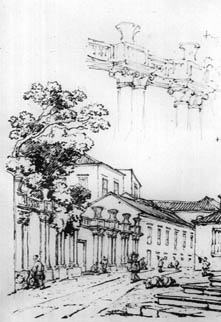 Illustration 3
The 'sixteen pillared house'.
GEORGE CHINNERY (°1774-†1852).
Pencil and pen. Dated "17th April 1836" (in pencil) and "29 July 1836" (in ink).
The City of Birmingham Art Gallery and Museum, United Kingdom.
Illustration 3
The 'sixteen pillared house'.
GEORGE CHINNERY (°1774-†1852).
Pencil and pen. Dated "17th April 1836" (in pencil) and "29 July 1836" (in ink).
The City of Birmingham Art Gallery and Museum, United Kingdom.
The Convento de Nossa Senhora da Penha de França (Convent of Our Lady of Penha de França), (Illustration 4) straddling the hilltop near the foot of the peninsula, was another seventeenth-century foundation rebuilt in Chinnery's time. The small houses in the foreground at first sight appear nondescript, but for the people of Macao they had a special significance. It was here that, in 1827 -two years before this drawing was made -- they were rented by Thomas College, surgeon to the British East India Company in Guangzhou, for use as an infirmary open to all, and specialising in eye disease. In the years 1827-1833 the infirmary treated the eyes of some four-thousand patients.
Chinnery made a number of studies of the Mage miao (Ama Temple) -- as did his French colleague Auguste Borget, who lived in Macao in 1838-1839 -- and the dramatic rock-formations just beyond the temple at the point of the peninsula. A drawing (Illustration 5) by Chinnery shows the temple's northern entrance, set against the lower slopes of Colina da Penha (Penha Hill); behind it a venerable banyan tree spreads its branches, protectively it seems, around the temple gateway.
Yet despite its undoubted documentary value, Chinnery's work cannot be regarded as an entirely objective view of Macao in the second quarter of the nineteenth century. Chinnery was the product of a particular artistic training. He studied in the early 1790s at the Royal Academy Schools in London, where the influence of Sir Joshua Reynolds and his precepts were still strong, where Thomas Lawrence was the rising star, and were Joseph Mallord William Turner was a fellow-student. Perhaps even more significant was the aesthetic of the 'Picturesque', which was at its peak in Britain during Chinnery's formative years, and which remained a potent element in Chinnery's artistic outlook throughout his life. The followers of 'Picturesque' principles believed that, in general, a building should be viewed from an angle rather than head-on; they valued variety and asymmetry, roughness and dilapidation. Chinnery no doubt recognised the abundance of these qualities in, the waterside homes created by the tanka boat-people, who fashioned dwellings by raising up their small craft of stones on wooden stilts: de depicted many of these semi-permanent structures on the beaches of Macao. (Illustration 6)
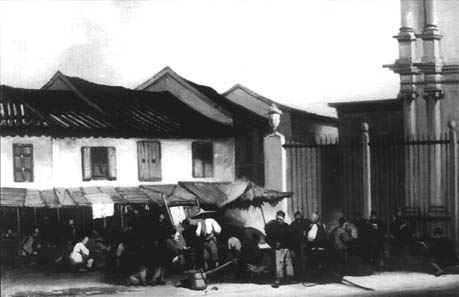 Street market in the square facing St. Dominic's(São Domingos) Church.
GEORGE CHINNERY (°1774-†1852).
Oil on canvas.
Private Collection.
Street market in the square facing St. Dominic's(São Domingos) Church.
GEORGE CHINNERY (°1774-†1852).
Oil on canvas.
Private Collection.
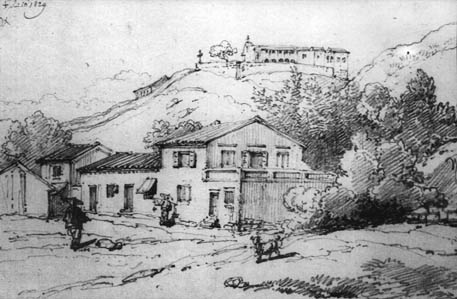 Illustration 4
Penha Hill with the Convent of Our Lady of Penha de Franca (Nossa Senhora da Penha de Franca) with Dr. College's dispensary in the foreground.
GEORGE CHINNERY (°1774-†1852).
Pencil. Dated" June 1829".
Photograph: Courtesy of the Martyn Gregory Gallery.
Illustration 4
Penha Hill with the Convent of Our Lady of Penha de Franca (Nossa Senhora da Penha de Franca) with Dr. College's dispensary in the foreground.
GEORGE CHINNERY (°1774-†1852).
Pencil. Dated" June 1829".
Photograph: Courtesy of the Martyn Gregory Gallery.
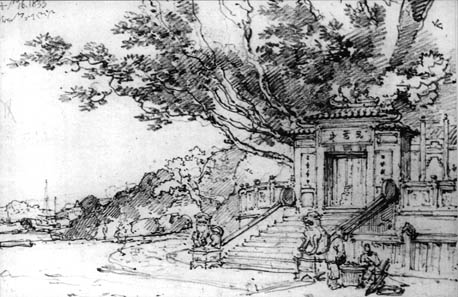 Illustration 5
The Temple of Ama in Macao.
GEORGE CHINNERY (°1774-†1852),
Pencil. Dated "16th April 1833".
Photograph: Courtesy of the Larger Galleries.
Illustration 5
The Temple of Ama in Macao.
GEORGE CHINNERY (°1774-†1852),
Pencil. Dated "16th April 1833".
Photograph: Courtesy of the Larger Galleries.
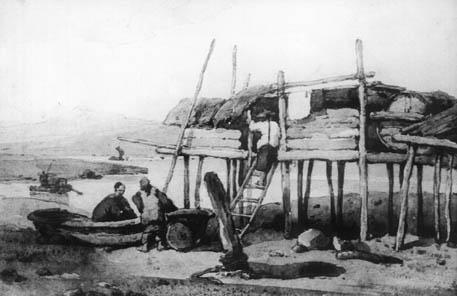 Illustration 6
Tanka boat-people's houses on stilts.
GEORGE CHINNERY (°1774-†1852).
Pen, ink and watercolour.
Photograph: Courtesy of the Martyn Gregory Gallery.
Illustration 6
Tanka boat-people's houses on stilts.
GEORGE CHINNERY (°1774-†1852).
Pen, ink and watercolour.
Photograph: Courtesy of the Martyn Gregory Gallery.
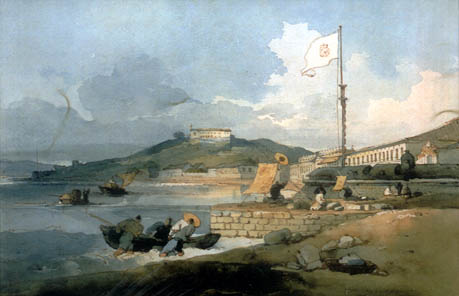 Illustration 7
The Praya Grande seen from the northeast with St. Peter's (São Pedro) Bulwark in the foreground.
GEORGE CHINNERY (°1774-†1852).
Crayon.
Mr. & Mrs. Thompson Collection.
Photograph: Courtesy of the Martyn Gregory.
Illustration 7
The Praya Grande seen from the northeast with St. Peter's (São Pedro) Bulwark in the foreground.
GEORGE CHINNERY (°1774-†1852).
Crayon.
Mr. & Mrs. Thompson Collection.
Photograph: Courtesy of the Martyn Gregory.
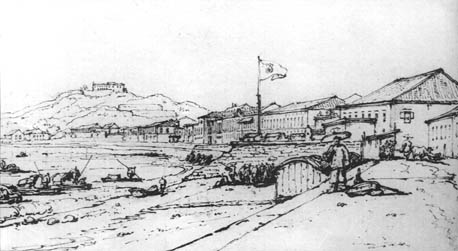 Illustration 8
The Praya Grande from the northeast with St. Peter's (São Pedro) Bulwark in the foreground.
GEORGE CHINNERY (°1774-†1852).
Pencil. Dated "June 1829".
Mr. & Mrs. Thompson Collection.
Photograph: Courtesy of the Martyn Gregory Gallery.
Illustration 8
The Praya Grande from the northeast with St. Peter's (São Pedro) Bulwark in the foreground.
GEORGE CHINNERY (°1774-†1852).
Pencil. Dated "June 1829".
Mr. & Mrs. Thompson Collection.
Photograph: Courtesy of the Martyn Gregory Gallery.
In addition we should consider the very personal quality of Chinnery's art. As he advised a pupil," When people talk of painting with their Eye, it is not the organ we see & see with on a clear day a mile on the Horizon, but the Mind's Eye, the Poet's Eye [...]."3 Although it occasionally seems to have failed him in his oil paintings, a 'poet's eye' is clearly revealed in Chinnery's drawings and watercolours of Macao. To borrow an apt phrase, Chinnery created "[...] a personal poetry of Macao [...];" 4 or as Chinnery himself observed in a shorthand note," It is the power of extracting the poetry from the prose of all objects in nature that constitutes the genius for both poetry and painting."5
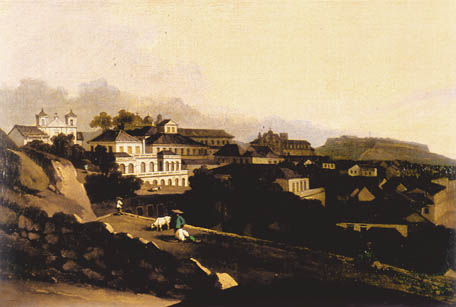
Illustration 9
The Praya Grande (Praia Grande) seen from the southwest - detail. GEORGE CHINNERY (°1774-†1852).
Oil on canvas.
A. J. Hardley Collection.
In the background, left to right: the rooftops of St. Lawrence's (São Lourenço) Church, St. Joseph's (São José) Church, St. Augustin's (Santo Agostinho) Church and the ramparts of Mount Fort (Fortaleza do Monte).
This personal vision incorporates the sense of Macao as a living place. The cumulative effect of Chinnery's drawings is a sense that the buildings of Macao are (or were) firmly rooted in a community -- a predominantly Chinese community, moreover, for the people whom the artist depicts within a largely European architectural setting are the Chinese barbers and street vendors, the fishermen and tanka boat- people, the tea-drinkers, the gamblers and the passersby. Occasionally we see a lady of Macao in her enveloping do (followed by an attendant holding aloft a parasol), or tall-hatted priests outside the gates of a church; but as a rule the wealthier Chinese, Macanese and Europeans are excluded from his street scenes, although, on an individual basis, they might well have commissioned Chinnery to paint their portraits.
The most celebrated general view of Macao was no doubt that of the Praia Grande (Praya Grande), viewed from either end of the sweeping bay. Chinnery drew and painted many views of the Praya, and yet they are seldom repetitive.
It is characteristic of Macao, with its hilly and varied terrain, that for the student of views and vistas, a short walk can often radically transform the prospect -- especially when (as sometimes occurs in Chinnery's case) a degree of artistic license is introduced. As we share Chinnery's broad view of the Praia Grande (Praya Grande) from the south-western end of the beach, (Poster) the hills of Macao make little impression, apart from the Guia in the distance; the artist's emphasis lies upon the long sweep of the bay and its celebrated architectural frontage. But he has to move his vantage-point only a few metres up the hill, (Illustration. 9) and the city is revealed as a complex structure of buildings and terraces rising up to the churches and convents -- São Lourenço (St. Lawrence), São José (St. Joseph's),Santo Agostinho (St. Augustine's) -- which dominate the ridge.
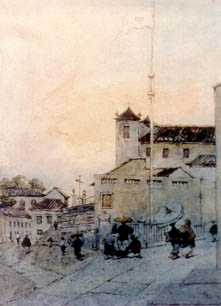
Street scene with the staircase leading to St. Lawrence's (São Lourenço) Church.
GEORGE CHINNERY (°1774-†1852).
Pen, ink and watercolour.
Private Collection.
Photograph: Courtesy of the Martyn Gregory Gallery.
When sketching the Praia Grande, it seems that Chinnery often favoured a spot just to the north of the Baluarte Sāo Pedro (St. Peter's Bulwark), which projected from the beach wall in front of the 'Palácio' ([Governor's] Palace). From this point, with small movements of position and changes in angle vision, Chinnery could produce a great variety of compositions, ranging from semi-formal architectural studies to scenes in which the buildings are upstaged by the human activity on the beach and in the shallow water. The Baluarte de São Pedro (St. Peter's Bulwark) flagstaff (Illustration. 7) and the tower of Igreja de São Lourenço (St. Lawrence's Church) are formal counterpoints to the stately horizontal procession of the English East India Company 'factories', old and new -- "[...] two large blocks of palatial-like buildings [...],"6 as the American merchant Gideon Nye described them -- which stood adjacent to the 'Palácio' ([Governor's] Palace).
Stepping back a few metres, Chinnery gains a wider view of the Praya and its beach activity. (Illustration. 8) Now the waves are allowed to froth and the Portuguese flag to flutter; sampans and egg-boats come and go, while the stonebreakers working beneath their bamboo-slung sunshades divert us still further from the architecture beyond.
In 1840, the general prospect of the Praia Grande became familiar to a wider audience on the other side of the world. As relations between Britain and China deteriorated, the British public took a closer interest in events on the South China coast; and in 1840 a huge panoramic "View of Macao and China" was exhibited in a purpose-built structure in Leicester Square, London. This panorama "view of Macao" was painted by Robert Burford, who did not travel to the East himself, but who would no doubt have had access both to engraved views and to Chinese 'export' paintings of the Praia. It is also possible that Burford made use of drawings by Chinnery; a pencil sketch of the Praia Grande (Praya Grande), with shorthand notes identifying some of Macao's residences, survives in a private collection. The panoramic painting has disappeared long since, but some idea of its scope can be gained from the key which was printed to accompany it. (Illustration. 10)
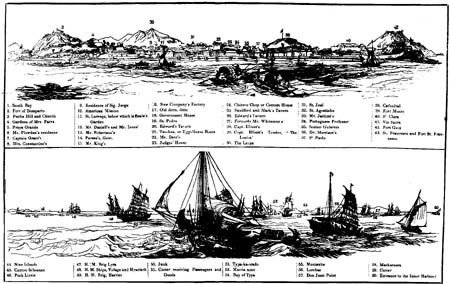
Illustration 10
Explanation of a View of MACAO in CHINA, now Exhibiting at the PANORAMA, LEICESTER SQUARE [London].
ROBERT BURFORD.
Photograph: Courtesy of the Martyn Gregory Gallery.
The 'Opium War' reduced the elderly artist to a state of theatrical panic. "I should like to paint a few good Pictures (at least try it) before I'm put to the Sword.", he wrote to James Matheson on the 23rd of February 1840; "[...] rely on it something serious if not dreadful is coming."7 As it turned out, he survived for another twelve years, during which, his talents little impaired by advancing years, he executed many elegant and lively drawings of Macao.
BIBLIOGRAPHY
ABBREVIATIONS
LCMSS: Library of Congress Manuscript Section, Washington, D. C.
MANUSCRIPT SOURCES
LCMSS:
Low Mills Family Papers,
•Boxes 13-14 --LOW, Harriet, Diaries.
• Boxes 22-23 -- HUMMEL, Arthur W., The journal of HarrietLow, [typed manuscript].
PRINTED SOURCES
•HILLARD, Catherine, My mother's journal. A young lady's diary of five years spent in Manila, Macao, and the Cape of Good Hope from 1829-1834, Boston, George H. Ellis, 1900.
•Dr. Thomas Boswell Watson 1815-1860, (Catalogue 40), London, Martyn Gregory Gallery, 1985, plate no 32.
•WATSON, Thomas Boswell -- See: Dr. Thomas Boswell Watson 1815-1860, [...].
•WATSON, Dr. [Thomas Boswell], A View of Macao seen from the Veranda of a House, probably the residence of Lord Napier, in "Fine China Trade Paintings (Fine Eighteenth, Nineteenth and Twentieth Century China Trade Paintings, Drawings, Watercolours and Prints)", Hong Kong, Sotheby Parke Bernet (Hong Kong) Ltd, 25 May 1981, lot 115.
•Fine China Trade Paintings (Fine Eighteenth, Nineteenth and Twentieth Century China Trade Paintings, Drawings, Watercolours and Prints), Hong Kong, Sotheby Parke Bernet (Hong Kong) Ltd, 25 May 1981.
•SOTHEBY Parke Bernet (Hong Kong)-- See: Fine China Trade Paintings (Fine Eighteenth, Nineteenth and Twentieth Century China Trade Paintings, [...].
•SOTHEBY Parke Benet (Hong Kong) -- See: WATSON, Dr. [Thomas Boswell], A View of Macao seen from the Veranda of a House, [...].
•ORMOND, R., George Chinnery and his pupil Mrs Browne, in "Journal of the Walpole Society", London, (44) 1974, pp.123-211.
•GUILLÉN-NUÑEZ, Céar, Macau through the Eyes of Nineteenth Century Painters, in CREMER, Rolf Dieter, "Macau City of Commerce and Culture, Hong Kong, UEA Press Ltd., 1987, pp.53-70.
•GUILLÉN-NUÑEZ, César, Introduction [to the Collection of the Geographical Society of Lisbon], in "George Chinnery -- Macau",(Galeria do Museu Luís de Camões / Museum Luís de Camões Gallery / Colecção do Toyo Bunko / Collection of Toyo Bunko / 5-30 Setembro 1985/ 5-30 September 1985) (Galeria do Leal Senado de Macau / Leal Senado of Macau Gallery / Colecção da Sociedade de Geografia de Lisboa / Collection of the Geographical Society of Lisbon / 6-30 Setembro / 6-30 of September), Macau, Leal Senado de Macau - Museu Luís de Camões, 1985, [p. n. n.].
•NYE, Gideon, Jrn., The morning of my life in Canton, comprising an outline of the history of foreign intercourse from the last year of the regime of the Honorable East India Company, 1833; to the imprisonment of the foreign community in 1839, Canton, [p. n. n.], 1873 [American Society and Statistical Society lecture, 31st of January 1937].
•CONNER, Patrick, George Chinnery, artist of India and the China coast, Woodbridge/Suffolk, Antique Collectors' Club, 1993.
NOTES
1 Library of Congress Manuscript Section [LCMSS], Washington D. C., Low Mills Family Papers, Boxes 13-14-LOW, Harriet, Diaries, "7th of May 1833".Also see: Library of Congress Manuscript Section [LCMSS], Washington D. C., Low Mills Family Papers, Boxes 22-23 -- HUMMEL, Arthur W., The journal of Harriet Low, [typed manuscript]; HILLARD, Catherine, My mother's journal. A young lady's diary of five years spent in Manila, Macao, and the Cape of Good Hope from 1829-1834, Boston, George H. Ellis, 1900--"7th of May 1833".
2 Dr. Thomas Boswell Watson 1815-1860, (Catalogue 40), London, Martyn Gregory Gallery, 1985, plate no 32: "Mr. Forbes's House"-- For a frontal drawing of this house by Chinnery's friend and follower Dr. Thomas Watson, inscribed by the artist.
Also see: WATSON, Dr. [Thomas Boswell], A View of Macao seen from the Veranda of a House, probably the residence of Lord Napier, in "Fine China Trade Paintings (Fine Eighteenth, Nineteenth and Twentieth Century China Trade Paintings, Drawings, Watercolours and Prints)", Hong Kong, Sotheby Parke Bernet (Hong Kong) Ltd, 25 May 1981, lot 115-- 11 1/4in by 19 1/2in--28.5 cm by 49.5 cm)-An oil painting showing the south-western prospect from this verandah.
3 ORMOND, R., George Chinnery and his pupil Mrs Browne, in "Journal of the Walpole Society", London, (44) 1974, pp.123-211, p.151 -- For a letter from Chinnery to Maria Browne, dated the 4th of November 1816.
4 GUILLÉN-NUÑEZ, Cesar, Macau through the Eyes of Nineteenth Century Painters, in CREMER, Rolf Dieter, "Macau City of Commerce and Culture", Hong Kong, UEA Press Ltd., 1987, pp.53-70, p.62.
5 GUILLEN-NUÑEZ, Cesar, Introduction [to the Collection of the Geographical Society of Lisbon], in "George Chinnery - Macau", (Galeria do Museu Luís de Camões / Museum Luís de Camões Gallery / Colecção do Toyo Bunko / Collection of Toyo Bunko/5-30 Setembro 1985 / 5-30 September 1985)(Galeria do Leal Senado de Macau / Leal Senado of Macau Gallery / Colecção da Sociedade de Geografia de Lisboa / Collection of the Geographical Society of Lisbon / 6-30 Setembro / 6-30 of September), Macau, Leal Senado de Macau - Museu Luís de Camões, 1985, [p. n. n.].
6 NYE, Gideon, Jrn., The morning of my life in Canton, comprising an outline of the history of foreign intercourse from the last year of the regime of the Honorable East India Company, 1833; to the imprisonment of the foreign community in 1839, Canton, [p. n. n.], 1873, p.22[American Society and Statistical Society lecture, 31st of January 1937].
7 CONNER, Patrick, George Chinnery, artist of India and the China coast, Woodbridge/Suffolk, Antique Collectors' Club, 1993, p.249 and notes.
*Specialist on art subjects related to the history of reciprocal exchanges between Europe and the Far East. Author of articles and publications on related topics. Former curator of the Royal Pavillion, Art Gallery and Museums, Brighton, UK. Presently, director of the Martyn Gregory Gallery, London, UK.
start p. 329
end p.